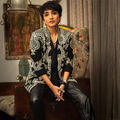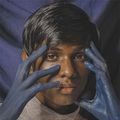Deepika GovindThe Bengaluru-based designer’s design philosophy is - ‘Fashion for the EARTH (E= environment, A = Art, R = Revolution, T = technology and H = human hand).’ She says, “Sustainable fashion is virtually an offshoot of the `ethical fashion’ movement, where individuals in the fashion industry take responsibility for the manner in which the garments are produced, keeping in mind its effects on the environment and human beings. In other words, it is socially-conscious, environment-friendly fashion.”
Elaborating further, she says, “Designers opt for natural fibres by minimizing or shunning use of synthetics altogether. Those committed to the cause use natural fibres that are grown without the use of chemicals or pesticides, such as choosing organic cotton over regular cotton that consumes a higher degree of pesticides.”
“Others in the industry try to ensure fair working conditions for skilled labour like tailors and embroiderers, energy-efficient processes, minimizing consumption of precious natural resources and the use of low impact dyes,” she adds.
Going green is the new buzzword everywhere and this buzz is spreading in the Indian fashion industry as well. The designers are #
During her career, Deepika Govind has created and developed several eco-friendly fabrics and pure blends, such as Khadi + modal/tencel, soya bean knits and Eri the Peace silk stoles and sarees.
Her Denim Green, an organic denim line, consumes 100th or even lesser water and much less electricity than a normal pair of factory-produced jeans. The effects on it are achieved by hand and chemical free techniques, as opposed to the effects one finds on a regular pair of jeans.
Agnimitra Paul
“Sustainable fashion for me is fashion down the years, which is evergreen and ecologically sound and it is not something only about fashion and trends, it is also about my individuality and expresses my personality,” says Agnimitra Paul.
According to her, fashion designers can play a major role in making fashion more sustainable because the fashion arena is entirely controlled by them. “The textiles and fabrics like jute and Khadi can be designed to make apparels look more glamorous for the masses. And as the masses’ demand for these creations increase, money and employment will automatically come to the weavers and craftsmen. In this way, the designers can do their bit for the community,” she opines.
“In India we have such wonderful and rich textiles and crafts, but the sad part is that we are not using those to the maximum and thus I feel there is so much of opportunity left and we can really make very stylish outfits out of our very own textiles and crafts,” she quips.
Ms. Agnimitra’s recent sustainable designing collection was showcased at the Blender’s Pride show where she used Khadi and Madhubani paintings extensively. “Currently fashion is about being subtle and understated. Khadi is perceived to be non-glamorous, however, I used Madhubani paintings on Khadi fabric and created both ethnic dresses like anarkalis and sarees as well as modern western dresses, and the Indo-western look was appreciated by all,” she reveals.
Fibre2fashion News Desk - India
































-Ltd..jpg?tr=w-120,h-60,c-at_max,cm-pad_resize,bg-ffffff)





.jpg?tr=w-120,h-60,c-at_max,cm-pad_resize,bg-ffffff)
.jpg?tr=w-120,h-60,c-at_max,cm-pad_resize,bg-ffffff)






